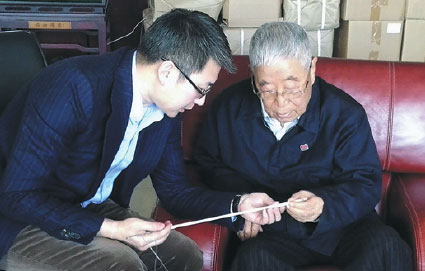New prostate procedure could bring relief to rural millions
Updated: 2016-01-28 08:07
By Zhao Xu(China Daily)
|
||||||||
A potential breakthrough in the treatment of benign enlargement of the gland may benefit men in China's countryside and across the globe. Zhao Xu reports.
Although it has been more than a decade, Jiang Hansheng can still remember the look on the face of "an expert in Beijing" when he eagerly explained a method he had experimented with for years to treat benign prostatic hyperplasia, or enlarged prostate gland, a condition that occurs frequently among men aged 60 and older.
"The expert simply smiled and shook his head slightly. And my heart sank," recalled Jiang, a retired urologist from Shandong province in East China. The open dismissal represented nothing new or surprising for the rural doctor, though. From the early 1990s, Jiang spent 10 years researching and performing a procedure called "balloon dilation of the prostrate"; he also expended a lot of time and effort attempting to convince his peers and superiors that the method was an effective treatment for BPH.
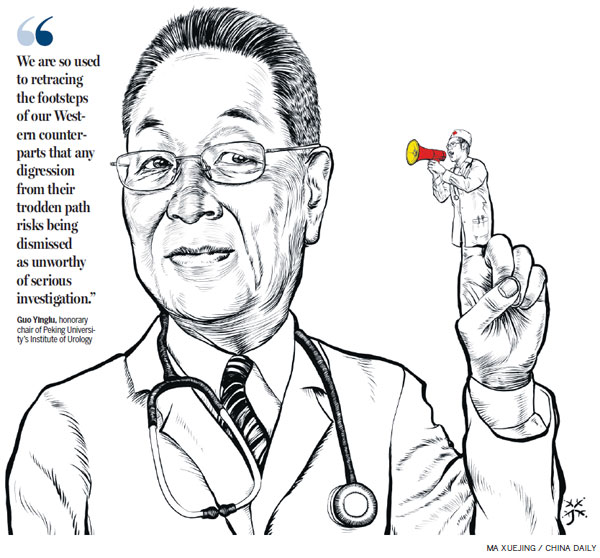
The condition is non-life threatening and rarely painful, but it can cause a range of problems, including the need to urinate frequently, involuntary urination and leakage, that can be frustrating and embarrassing for the patient.
"The urethra is partially surrounded by the prostate grand, which in turn is encased within a hard capsule of membrane," said Tian Long, an urologist at Chaoyang Hospital in Beijing. "With the total volume inside the capsule remaining unchanged, an enlarged prostate means a narrower space for the urethra, which in turn gives rise to many urinary symptoms concerning both storage and voiding."
Tian is one of six patent-holders of a surgical procedure called "Transurethral Columnar Balloon Dilation of the Prostate", known to doctors as TDUP. The procedure, which usually takes about five minutes, involves inserting a long, column-shaped balloon into the section of the urethra enveloped by the prostate and then inflating it. Ideally, the dilated urethra exerts pressure on the capsule around the prostate, causing it to break within minutes. "Once broken, the capsule can never grow back together and therefore all the inner pressure is released once and for all. This means that the urethra will feel no pressure however large the prostate becomes in the future," Tian said.
"The short procedure time has sharply reduced the risk of cardio-cerebrovascular diseases, such as thrombosis, and fatal pulmonary embolism (blood clots in the lungs) that has a high rate of occurrence among senior patients," he said, comparing the procedure with electrotomy, the use of high-frequency electric current to cut or destroy tissue, and laser surgery, the predominant methods of treating BPH. Both methods take about an hour to complete and involve the removal of all or some of the prostate.
"Last year, a 94-year-old man underwent the balloon-dilation procedure, followed by a 92-year-old veteran soldier. Both were too weak and physically unstable to seriously consider other options."
Lack of acceptance
Although the procedure sounds quick and easy to perform, gaining wider acceptance among the medical community has not been easy for Jiang, or those who believe his method has a future.
"The idea of prostate dilation was not my invention," he said. "It was first introduced to China from the West, in the 1980s. Back then, the balloon was shaped like a ball, not a column. Many urologists in China, including myself, performed the procedure. But the results were far from satisfactory, and the procedure was completely abandoned after just one or two years."
It was forgotten by everyone except Jiang, who trusted his medical instincts and began a decade of experimentation with the procedure. In the 1990s, Jing Xuejun, who worked with a medical equipment manufacturer that was owned by the government at the time, not only witnessed but also joined Jiang's endeavor.
"Jiang came to us and asked whether we could make the balloons he needed," Jing recalled. "Over the next few years, we created a bewildering array, of all sizes and shapes, for him to try."
The balloons produced mixed results, but Jiang was unable to pinpoint the exact reasons behind success and failure. His inability to provide plausible explanations meant he and his method were rejected, and sometimes ridiculed.
While some traces of the ridicule still lingers, at least there is an explanation now, according to Guo Yinglu, honorary chair of Peking University's Institute of Urology and China's leading urologist.
"Long-term results depend on whether dilation of the urethra has causes the capsule of the prostate to break or not. If yes, then in most cases, success is guaranteed; if no, then it's inevitably a failure," the 86-year-old said. "Why? Because if the capsule is not ruptured, even if the urethra is dilated by the entry of the balloon, it will be squeezed back to its original state by the surrounding prostate tissue once the balloon is removed."
A decade of research
For the past decade, Guo has headed a research team, including Tian, which has focused on TUDP. After patenting the procedure nationally in 2012, the team is now gathering more clinical evidence and promoting the procedure among doctors across China, from national to county level.
"At a time when creativity is celebrated worldwide, it's still hard for Chinese doctors to break new ground," Tian, 45, said. "Any creative idea in medicine requires the input of capital and technology to become clinically applicable. The congregation of people in various related industries provides fertile ground for the growth of such ideas, as is often the case in the United States. In China, we still very much lack that environment."
But all Jiang, the county doctor, required were just a few tailor-made balloons and a sympathetic ear in higher authority with the resources to offer theoretical support to his clinical experiments and a platform to tell others about the findings. He knocked on many doors before he met Guo about 12 years ago.
"The biggest obstacle for any innovative Chinese doctor, low-level doctors especially, lies in conventional thinking," Guo said. "We are so used to retracing the footsteps of our Western counterparts that any digression from their trodden path risks being dismissed as unworthy of serious investigation."
According to Tian, electrotomy and laser surgery have long been championed as the global "gold standard" for BPH treatment. "Traditionally, the capsule of the prostate is a no-go zone. People worry that insertion of the balloon will exert pressure on the sphincter, the ring of muscles that sits right below the prostatic apex (the base of the prostate) whose proper function is essential to the control of urination. Any potential damage of the muscle may lead to urinary incontinence, or involuntary urination," he said. "But in practice, this (damage) has very rarely happened, and that may be because the balloon is quickly moved further into the urethra to relieve the pressure on the sphincter. It's a matter of just a minute."
Guo said the procedure is significant not only because it offers an entirely new concept of the enlarged prostate treatment, but also because the treatment is tailor-made for people who live far from big cities and are not financially well-off.
That's old news to Jiang, who said that back in the 1990s and early 2000s, many rural patients opted for his method simply because they didn't have any other choice. "Electrotomy and laser surgery didn't appear in China's county-level hospitals until the early 2000s," he said, adding that he performed the procedure on about 1,000 patients between 1990 and 2004, with a success rate of about 75 percent. Later, Guo's team stepped in, making constant modifications to the balloon and establishing the overall protocol for the procedure.
According to Tian, another factor that makes the procedure ideal for use in rural hospitals is that it's very easy to learn. "A doctor needs to deal with at least 100 cases to master electrotomy or laser surgery, but with balloon dilation all that's required is a tube of silica gel and an urologist who has performed the procedure more than 10 times," he said.
Lukewarm welcome
Despite its apparent benefits, the procedure has received a lukewarm welcome in Chinese hospitals. "Nationally, about 400 balloon dilations were performed between June and December at about 150 hospitals in China," Tian said, noting that most of the hospitals were located in second- or third-tier cities and counties. The procedure is only performed at three hospitals in Beijing, including Chaoyang Hospital, Tian's employer.
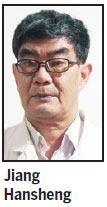
In the past 12 months, Tian has performed about 30 balloon-dilations, although mostly outside Beijing. "The operation is covered by national medical insurance in just six out of 32 provincial-level administrative regions on the Chinese mainland, excluding Beijing," he said.
Even within his own urological department, Tian faces opposition because few of his colleagues are as enthusiastic about the procedure as he is.
That's understandable, according to Zhang Yushi, deputy director of the urological department at Peking Union Medical College Hospital, China's most prestigious hospital, who has listened to Guo's lecture on the procedure, but hasn't yet witnessed it.
"Personally, I have reservations about the method. I don't think any doctor in our department would vote for it. The whole thing sounds implausible to me. And they don't have enough statistics to support what they are doing," he said.
Zhang has a point. Guo estimates that his success rate is now about 85 percent, similar to electrotomy and laser surgery, but as only about 1,000 people have undergone the procedure since 2008, by which time it had matured, it's still difficult to assess its effectiveness compared with other methods, especially the long-term impact on patients.
To improve the flow of data, Guo is planning to oversee research into the procedure in several hospitals that will cooperate in a comparative clinical study that's scheduled to begin sometime before June.
He applauded Jiang for his "stubbornness". "None of this would be possible without his perseverance," he said. Guo has attracted more than 1 million yuan ($150,000) to the project's research fund, mostly as a result of his reputation and status as China's top urologist.
A global problem
Worldwide, 60 percent of all men aged 60 and older suffer from an enlarged prostate gland. For men age 70 and older the figure rises to 70 percent, and for men age 80-plus it is 80 percent.
"For every medical expert in Beijing or Shanghai, there are tens of thousands, and probably hundreds of thousands, of doctors working at the grassroots level. Their first-hand knowledge of the situation on the ground sometimes makes them the best-positioned - despite the belief voiced by many experts - to tackle the issues faced by their patients and hospitals, including a lack of funds and a shortage of well-trained doctors," he said. "Their inventions and innovations are often aimed directly at solving those problems. However, that doesn't mean that what they have come up with are makeshift measures inferior to international practices."
"It's the responsibility of national medical research institutions and hospitals to push forward such ideas and practices, to continue the relay if it's deemed valuable. And the government should establish a channel so voices from down below can be heard and judged fairly," he said.
In around 2004, Guo attended a medical conference in Qingdao, Shandong. "I asked a participating doctor what he thought of Jiang's cause, and the answer was: 'Don't waste time on him. He's a madman.' "
Jiang, who retired in 2011, appreciates the work undertaken by Guo and his team and the support they have shown. "They have made sure my life's work isn't wasted and have proved that, in the end, I'm not completely mad," he said.
Contact the writer at zhaoxu@chinadaily.com.cn
|
Renowned urologist Guo Yinglu (right) and urologist Tian Long are among six patent-holders for the procedure known as Transurethral Columnar Balloon Dilation of the Prostate. Provided to China Daily |
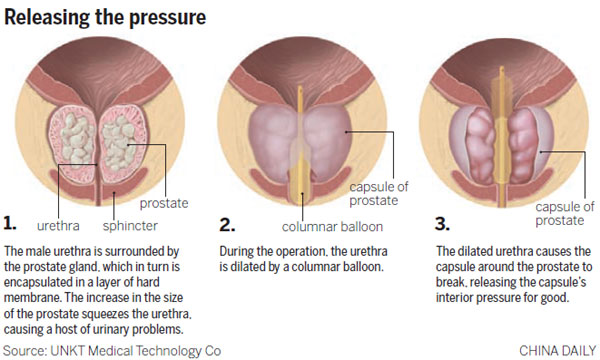
(China Daily 01/28/2016 page6)
- A glimpse of Spring Rush: little migrant birds on the way home
- Policy puts focus on genuine artistic students
- Police unravel market where babies are bought, sold as commodities
- More older pregnant women expected
- Netizen backlash 'ugly' Spring Festival Gala mascot
- China builds Mongolian language corpus
- Thousands of beckoning cat on display in Japan's Goutoku Temple
- Chinese fishing boat capsizes off S. Korean island: Yonhap
- 42 cases of Zika infection reported in N.E. Panama
- US announces further amendments to Cuba sanctions
- Special envoy to visit Laos and Vietnam
- El Nino expected to wreak havoc in S. America well into 2016

 Sea ice traps boats as cold wave sweeps across East China
Sea ice traps boats as cold wave sweeps across East China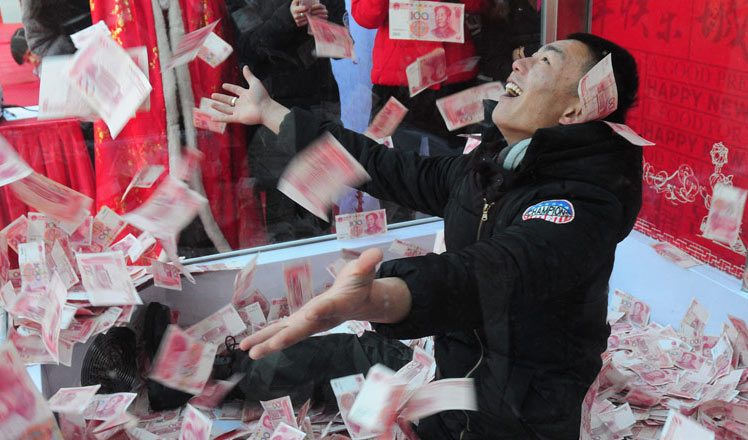
 10 tourists grab free money in one minute in East China
10 tourists grab free money in one minute in East China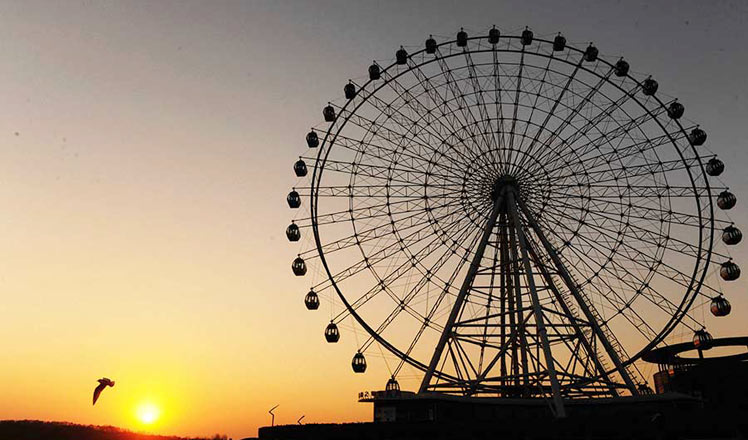
 Warm colors at sunrise cast off the chill in Qingdao
Warm colors at sunrise cast off the chill in Qingdao
 Artists use many techniques to create New Year monkeys
Artists use many techniques to create New Year monkeys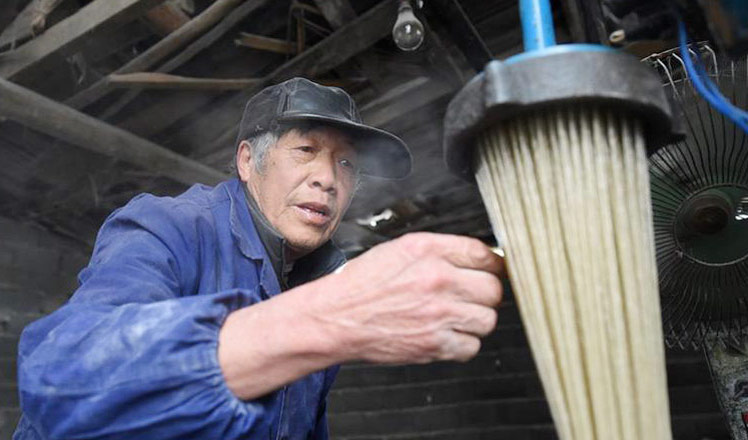
 Villagers make sweet potato vermicelli in China's Guangxi
Villagers make sweet potato vermicelli in China's Guangxi
 Creation of China Daily's Tibetan-style font
Creation of China Daily's Tibetan-style font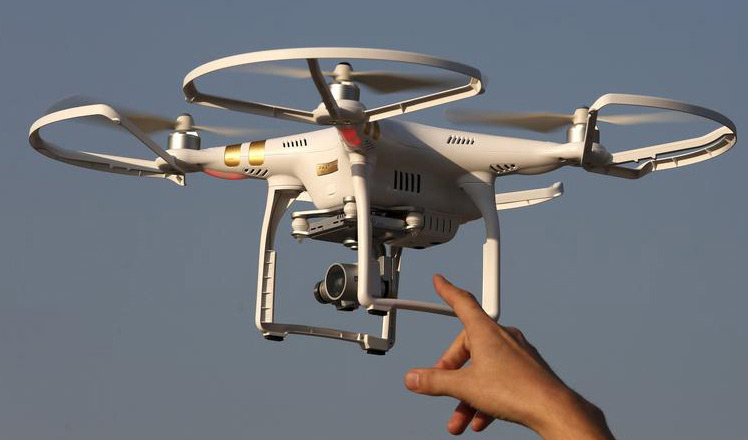
 Drone makers see soaring growth but dark clouds circle industry
Drone makers see soaring growth but dark clouds circle industry China's Zhang reaches Australian Open quarterfinals
China's Zhang reaches Australian Open quarterfinals
Most Viewed
Editor's Picks

|

|

|

|

|

|
Today's Top News
National Art Museum showing 400 puppets in new exhibition
Finest Chinese porcelains expected to fetch over $28 million
Monkey portraits by Chinese ink painting masters
Beijing's movie fans in for new experience
Obama to deliver final State of the Union speech
Shooting rampage at US social services agency leaves 14 dead
Chinese bargain hunters are changing the retail game
Chinese president arrives in Turkey for G20 summit
US Weekly

|

|
